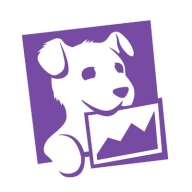

Datadog and Loom Systems compete in IT monitoring and management. Datadog is preferred for its extensive integration capabilities, while Loom Systems is known for its AI-driven analytics. Datadog's integration versatility makes it slightly more favorable due to its ability to adapt to diverse IT environments, despite Loom’s strength in advanced analytics.
Features: Datadog offers robust cloud monitoring, customizable dashboards, and extensive third-party integrations. Loom Systems provides powerful anomaly detection, predictive insights, and intuitive visualization tools. Datadog's integrations support a wide range of infrastructures, whereas Loom Systems focuses on AI-driven system behavior insights.
Room for Improvement: Datadog could enhance its analytics capabilities and feature more AI-driven insights like Loom Systems. Meanwhile, Loom Systems may benefit from expanding its integration options, improving user interface customization, and addressing potential scalability challenges to better accommodate larger systems.
Ease of Deployment and Customer Service: Datadog provides an easy cloud deployment with ample support resources, improving its integration efficiency. Loom Systems offers an AI-focused deployment strategy, enhancing ease of use for businesses utilizing predictive analytics. Datadog's customer service is comprehensive, supporting diverse deployments, whereas Loom emphasizes AI-focused assistance to optimize system performance.
Pricing and ROI: Datadog's pricing structure is tier-based, offering flexibility and scalability, resulting in solid ROI. Loom Systems may require a higher initial investment due to its AI capabilities but offers significant ROI through predictive maintenance and reduced downtime. Datadog's adaptable pricing appeals to various monitoring needs, while Loom provides high-value investment in predictive technologies for potentially superior long-term ROI. Exact prices may vary and should be confirmed with vendors.


Datadog is a comprehensive cloud monitoring platform designed to track performance, availability, and log aggregation for cloud resources like AWS, ECS, and Kubernetes. It offers robust tools for creating dashboards, observing user behavior, alerting, telemetry, security monitoring, and synthetic testing.
Datadog supports full observability across cloud providers and environments, enabling troubleshooting, error detection, and performance analysis to maintain system reliability. It offers detailed visualization of servers, integrates seamlessly with cloud providers like AWS, and provides powerful out-of-the-box dashboards and log analytics. Despite its strengths, users often note the need for better integration with other solutions and improved application-level insights. Common challenges include a complex pricing model, setup difficulties, and navigation issues. Users frequently mention the need for clearer documentation, faster loading times, enhanced error traceability, and better log management.
What are the key features of Datadog?
What benefits and ROI should users look for in reviews?
Datadog is implemented across different industries, from tech companies monitoring cloud applications to finance sectors ensuring transactional systems' performance. E-commerce platforms use Datadog to track and visualize user behavior and system health, while healthcare organizations utilize it for maintaining secure, compliant environments. Every implementation assists teams in customizing monitoring solutions specific to their industry's requirements.
We monitor all IT Infrastructure Monitoring reviews to prevent fraudulent reviews and keep review quality high. We do not post reviews by company employees or direct competitors. We validate each review for authenticity via cross-reference with LinkedIn, and personal follow-up with the reviewer when necessary.